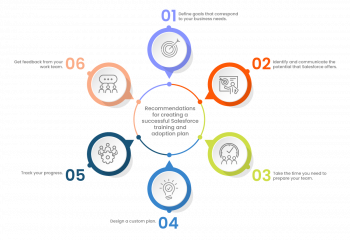The adoption of Salesforce means a change in the way we do things. This decision is not taken lightly and is the result of a diagnosis where a set of objectives is identified that cannot be achieved using traditional tools. When you decide to adopt a new platform like Salesforce for the benefit of your business, it means that you are willing to make all the necessary modifications to successfully complete this task. But it is not as simple as it seems. Most people demand and need change, but resist when it comes.
Resistance to change is a natural process that is present in the day-to-day life of every organization and it’s crucial that you help your Salesforce users navigate through this process in the best way possible. When it comes to Salesforce adoption, you must help your team understand implementation as a positive aspect of their work, not as a barrier that prevents them from moving forward and performing their responsibilities better. Training will become a necessity to carry out Salesforce adoption. Successful Salesforce adoption will depend largely on successful training that matches general and custom adoption capabilities.
Recommendations for creating a successful Salesforce training and adoption plan

1- Define goals that correspond to your business needs
If you want to execute a successful Salesforce adoption, complemented by an excellent training plan, you have to identify and define the goals you want to achieve. This will be the starting point to meet your business needs and expectations. What do you want to achieve with Salesforce? Higher sales numbers? Better data management? Better customer service? More insightful analytical reports? These questions will help you define clear and precise objectives. Communicate at all times with your work team, and let them know what is expected of each of them and what they can expect from Salesforce.
2- Identify and communicate the potential that Salesforce offers
Sometimes decisions are made that can generate disagreements within the organization. So to prevent this, rely on an effective communication plan that allows you to make decisions that also consider the opinions of your workers. Keep your team updated on the potential that Salesforce presents and the positive impact it will have on their work performance. Update your training plan every time a new Salesforce version is released. This will ensure that your work team knows the latest updates on the platform and can use them to carry out their duties.
3- Take the time you need to prepare your team
Doing things lightly never brings good results. Don’t expect your team to fully exploit Salesforce capabilities overnight. Be sure to set goals so that your training and adoption plan includes activities for the short, medium, and long term. With this, you can guarantee that your team gradually grows and develops their knowledge in the use of the platform.
Make a training plan with effective, relevant actions that adapt to the needs of your users. This will ensure that each of your team members learns what they really need to run their daily activities and easily adopt Salesforce.
4- Design a custom plan
Identify your users and keep them in mind from the moment you start designing your plan. Remember that not everyone performs the same activities or has the same training cycles, so once you have identified them, make a training plan that is relevant and corresponds with each of their training needs. At SkyPlanner, we propose a role-based training, focused on the specific requirements of each of the organization’s unique roles.
You can incorporate benefits and recognition of workers into your training plan. This can be a source of motivation for your team and they can take full advantage of the benefits that Salesforce has to offer. Additionally, you can create and adapt supplementary material before, during and after the training (terminology used in Salesforce so that they become familiar with it, good practices, experiences, etc.).
Emphasize the importance of training and make sure your management team has all the tools it needs to support it and keep them engaged from start to finish. Their help and support are key to encouraging users to adopt Salesforce with ease.
5- Track your progress
After Salesforce is adopted, you need to assess the impact it has had. Define key performance indicators (KPIs) that help you measure how effective your Salesforce training plan has been and how efficient the actions taken for its adoption have been. As an example we find:
- Login rates.
- Percentage of non-mandatory fields completed in Accounts, Contacts, and Opportunities.
- Number of Chatter posts and updates.
- Number of activities created to record meeting notes and phone calls.
6- Get feedback from your work team
Communication with your work team favors continuous improvement to achieve the proposed objectives. Analyze their behavior and encourage feedback about the training and what the journey of Salesforce adoption has been like. Make sure they rate aspects such as training, communication, use of the platform, etc. This will allow you to understand how your team is handling the transition and identify areas that need improvement.
Some key aspects that you should not ignore
- Salesforce is a platform that contains various functionalities, so its application has to correspond with the main objectives of the organization and the areas where it is used. Therefore, you must focus the training towards the set of skills that you want to develop in your end users.
- Use Trailhead as the most comprehensive training resource for Salesforce. It offers a large number of training courses and is a useful source of online self-help for organizations. The content is structured in units, modules, badges, projects and trailmixes (a combination of all these), which guide the user in an easy and friendly way through Salesforce and facilitates learning and evaluation of the content.
- Track learning goals for your team members, either using Salesforce capabilities or other tools that allow you to do so.
- Document and keep available for use all the information related to the training of end users that can be incorporated into the work team. This helps new members adopt Salesforce more effectively.
- Make sure you take into account the opinion of your users before, during and after the training and adoption process. Take the time to get feedback, receive questions, and provide answers to your Salesforce users.
A successful adoption of Salesforce will largely depend on successful training that corresponds to the general and personalized needs of your workers, areas, and departments. Orient the capabilities of Salesforce with your goals and try to use all available training resources. Evaluate the impact Salesforce has on your organization and get feedback from your team. Keeping all these ideas in mind can help guarantee the success of your business.



